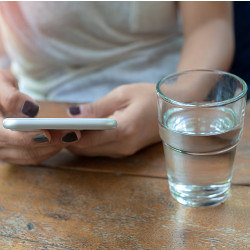
How many times have you wondered if the tap water in the hotel you just checked into is safe to drink? Have you ever wanted to check the amount of alcohol concentration in a drink served by a kind bartender? If you have, you might be able to find the answers right from your mobile phone using the new technique recently introduced by a group of MIT computer scientists to measure surface tension of a liquid. This technology can potentially not only confirm any water contamination and measure alcohol concentration, but also identify the presence of substances in liquid for diagnosis in healthcare or detect counterfeit luxury goods such as brandy or perfume.
Existing liquid testing methods are often based on a liquid's measurable properties such as electric permittivity, optical absorption, and so on. Surface tension is another property of liquids, representing the tendency of liquid surfaces to shrink into the minimum surface area possible, resulting from the greater attraction of liquid molecules to each other. However, it is one of the most difficult properties to measure and requires high-cost and sophisticated instruments, called tensiometers. Examples of these tensiometers include Du Noüy ring, Wilhelmy plate, spinning drop, pendant drop, bubble pressure, and acoustic levitation. Although such tensiometers can achieve high accuracy, their measurements are often performed in-lab due to the complexity of hardware, preparation, and manual procedures. To address these drawbacks, recent efforts on measuring surface tension using mobile devices have shown some promising results. However, its current poor performance and complexity are the two main reasons for its low adoption.
The following paper proposes a novel technique for determining the surface tension of a liquid by leveraging the optical absorption of waves propagating on the fluid surface. Using the equation for surface tension, this method tries to infer the wavelength of capillary waves—the key relation to the given liquid property. However, making a correct inference of the wavelength is challenging. Specifically, the first challenge stems from very shallow capillary waves produced by the phone vibrations on the liquid surface inside the container. Another challenge is due to the basic mechanism of the camera-rolling shutter, which leads to unexpected motion artifacts. When these challenges combine, it not only blurs the wave pattern in the photos captured by the phone's camera but also complicates the processing of these photos for wavelength estimation.
Without adding supportive hardware, the authors propose a neat set of techniques to achieve equivalent performance to in-lab manual tensiometers that confidently demonstrate the success of this research. One remarkable insight that helps the authors arrive at their solutions is the observation that the reflection of the shallow waves at the bottom of the container by the phone's flashlight correlate to the clearness of their pattern in the photos, which helps solve the first challenge. In addition, the authors leverage the intrinsic working mechanism of the hardware to pinpoint the motion artifacts sourcing from the camera-rolling shutter, which helps resolve the second challenge. As a result, their proposed technique can reduce the inherent poor performance of wavelength inference in existing approaches.
The following paper proposes a novel technique for determining the surface tension of a liquid by leveraging the optical absorption of waves propogating on the fluid's surface.
Applying the proposed solutions, the implemented system is able to gain very intriguing results, which have an absolute surface tension error of 0.75mN/m, compared to an in-lab manual tensiometer with a resolution of 0.5mN/m. Interestingly, the proposed method can measure the surface tension with values very close to the actual measurement in alcohol concentration, water contamination detection, and protein-level tracking in urine—a pivotal physiological index used in controlling diabetes and kidney disease.
These results illustrate the proposed technique is the first thorough mobile application able to precisely measure liquid surface tension simply using the camera, the flashlight, and the built-in vibro-motor on smartphones. This line of research opens multiple potential applications as well as research directions. The very next logical steps along this line of research includes improving its performance, applying the technique to other practical applications such as food safety, counterfeit goods detection, and validating such fakery in real-world settings with real-world deployments.



Join the Discussion (0)
Become a Member or Sign In to Post a Comment